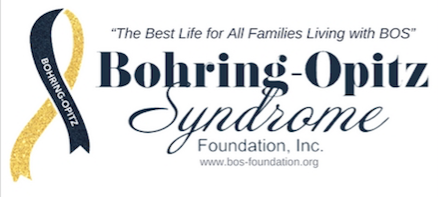Discussing the Inheritance Pattern for Bohring-Opitz Syndrome
Over the past year, more patients have been diagnosed with Bohring-Opitz Syndrome. As the numbers have increased, questions have also. Many families wonder what their chances are of having another child with BOS. The BOS Foundation asked Dr. Bianca Russell for her medical advice to help answer some of these questions for our families. We are very thankful for the continued support Dr. Russell has for patients with Bohring-Opitz Syndrome.
WHAT IS THE INHERITANCE PATTERN FOR ASXL DISORDERS?
Syndromes caused by genetic changes (mutations) in the ASXL genes (ASXL1, ASXL2, ASXL3) are inherited in an autosomal dominant (AD) fashion. This means that only one genetic change is needed to cause the syndrome. AD disorders can run in families for many generations or can be new (de novo) in the identified patient. When an AD condition is present in multiple generation, it is usually a more mild condition that does not impact reproduction (thus allowing the condition to be passed on many times). For the ASXL syndromes, we expect the inheritance to be de novo with a new change that has occurred in the child and not "inherited" from healthy parents.
WHY ARE THERE REPORTS NOW OF "INHERITED" ASXL DISORDERS?
We know that even in primarily AD de novo conditions, the child's genetic change can sometimes be inherited from a parent. This is typically caused by what is known as germline mosaicism. For ANY de novo condition, we cite the statistic that there is a 1% chance it can happen again in a future pregnancy. This is because there can be changes in a parent's egg or sperm that don't impact the parent but can be passed on to their child. A parent may also be mosaic for more than just their egg or sperm which could (but may not be seen) in their blood, skin or cheek tissues. This means that some of their cells have the genetic change of their child but not enough cells are affected to cause disease.
Several families have now reported having siblings with the same ASXL genetic change or a parent with mosaicism. While this is seen throughout the genetics world, it seems to be occurring in a higher frequency than would be expected in ASXL families though more research is needed.
WHAT ARE THE OPTIONS FOR MY FAMILY PLANNING?
This is a very challenging question and requires that you work with your local genetics team to determine the best options for your family. Here are a few points to consider:
1. If parents did not provide a sample to be tested with their child's testing, it was likely assumed to be inherited in a de novo fashion. Parents can be tested at a relatively affordable rate for the same change as their child if this was not done on testing such as a whole exome. While negative parental testing is reassuring, it does not make the recurrence risk zero for the below reasons.
2. When someone is mosaic for a genetic condition, not all their tissues are impacted so we may not sample the correct tissue to find it. We are often more likely to find that someone has a small percentage of affected cells if we test skin or cheek cells over blood cells though this may not always be possible.
3. Because we do not sample eggs or sperm, we do not have a test for gonadal mosaicism. Therefore, even with negative parent testing, there remains at least a 1% chance multiple children in a family could have the same ASXL disorder.
4. While risk of recurrence remains low, a family can opt for genetic testing during a pregnancy in the form of placental (CVS) or amniotic fluid testing. Testing of an early embryo in the lab through IVF and genetic testing can likely be done if parents are found to be mosaic. IVF is likely not possible when parents both test negative for their child's ASXL mutation. You will need to discuss IVF options further with an expert in this field.
5. Siblings for children with ASXL disorders are highly unlikely to pass on the condition to their children but there remains the small possibility that they inherited a change from a parent that remains in low levels in their bodies without causing issues for them. In this case, they could theoretically pass this on to their children.

